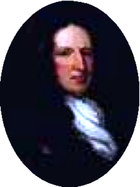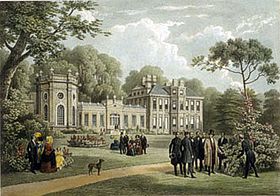
James Johnston (Secretary of State)
Encyclopedia

Secretary of State, Scotland
The Secretary of Scotland was a senior post in the pre-Union government of Scotland.The office appeared in the 14th century when it was combined with that of Keeper of the Privy Seal. Called Clericus Regis , he was regarded as an Officer of State...
, 1692-96 and Lord Clerk Register
Lord Clerk Register
The office of Lord Clerk Register is the oldest surviving Great Officer of State in Scotland, with origins in the 13th century.The Clerk-Register was from ancient times the principal Clerk in the kingdom, from whom all other clerks, whatever their government positions, and who were essentially his...
1704-5.
He was the fourth son of Lord Warriston, Archibald Johnston (1610–1663), who was executed by Charles II
Charles II of England
Charles II was monarch of the three kingdoms of England, Scotland, and Ireland.Charles II's father, King Charles I, was executed at Whitehall on 30 January 1649, at the climax of the English Civil War...
on 26 July 1663 for having served under Cromwell
Oliver Cromwell
Oliver Cromwell was an English military and political leader who overthrew the English monarchy and temporarily turned England into a republican Commonwealth, and served as Lord Protector of England, Scotland, and Ireland....
, and his second wife Helen, daughter of Alexander Hay, Lord Fosterseat.
Secretary of State for Scotland
James, with other members of his family, fled to Holland after his father's death. He studied law in UtrechtUtrecht (city)
Utrecht city and municipality is the capital and most populous city of the Dutch province of Utrecht. It is located in the eastern corner of the Randstad conurbation, and is the fourth largest city of the Netherlands with a population of 312,634 on 1 Jan 2011.Utrecht's ancient city centre features...
and according to John Macky (writer and secret agent during the reigns of King William
William III of England
William III & II was a sovereign Prince of Orange of the House of Orange-Nassau by birth. From 1672 he governed as Stadtholder William III of Orange over Holland, Zeeland, Utrecht, Guelders, and Overijssel of the Dutch Republic. From 1689 he reigned as William III over England and Ireland...
, Queen Anne and King George I
George I of Great Britain
George I was King of Great Britain and Ireland from 1 August 1714 until his death, and ruler of the Duchy and Electorate of Brunswick-Lüneburg in the Holy Roman Empire from 1698....
), was most proficient.
He returned just before the Glorious Revolution
Glorious Revolution
The Glorious Revolution, also called the Revolution of 1688, is the overthrow of King James II of England by a union of English Parliamentarians with the Dutch stadtholder William III of Orange-Nassau...
of 1688, bringing William of Orange to England in the same year. After the accession of William, Johnston was sent to the Elector of Brandenburg
Frederick I of Prussia
Frederick I , of the Hohenzollern dynasty, was Elector of Brandenburg and Duke of Prussia in personal union . The latter function he upgraded to royalty, becoming the first King in Prussia . From 1707 he was in personal union the sovereign prince of the Principality of Neuchâtel...
with a gift of the Order of the Garter
Order of the Garter
The Most Noble Order of the Garter, founded in 1348, is the highest order of chivalry, or knighthood, existing in England. The order is dedicated to the image and arms of St...
. On his return in 1692, he was appointed Joint Secretary of State for Scotland with John Dalrymple
John Dalrymple, 1st Earl of Stair
John Dalrymple the Master of Stair was a Scottish noble who played a crucial role in the 1707 Treaty of Union between the Kingdom of Scotland and the Kingdom of England, that created the Kingdom of Great Britain....
.
Johnston was a dedicated Presbyterian and as such agitated for the empowerment of the commoners and their independence from the nobility.
Marriages
In 1696 at SalisburySalisbury
Salisbury is a cathedral city in Wiltshire, England and the only city in the county. It is the second largest settlement in the county...
he married Catharine Poulett, third daughter of John, 2nd Baron Poulett
John Poulett, 2nd Baron Poulett
John Poulett, 2nd Baron Poulett , of Hinton St George in Somerset, was an English peer and Member of Parliament who fought on the Royalist side during the English Civil War....
by his first wife, Catharine née Vere. There were no surviving children.
In 1716 he married Lucy daughter of Thomas Claxton of Dublin, sister of Frances Countess of Rosse and Viscountess Jocelyn, sister of Mary Carter
Thomas Carter (1690–1763)
Thomas Carter was a politician, a Member of Parliament, Master of the Rolls, Privy Councillor and Secretary of State for Ireland. He was "an able and intriguing man" - Horace Walpole, 4th Earl of Orford.-Political career:...
, cousin of Edward Lovett Pearce
Edward Lovett Pearce
Sir Edward Lovett Pearce was an Irish architect, and the chief exponent of palladianism in Ireland. He is thought to have initially studied as an architect under his father's first cousin, Sir John Vanbrugh. He is best known for the Irish Houses of Parliament in Dublin, and his work on Castletown...
, cousin of Sir John Vanbrugh
John Vanbrugh
Sir John Vanbrugh – 26 March 1726) was an English architect and dramatist, perhaps best known as the designer of Blenheim Palace and Castle Howard. He wrote two argumentative and outspoken Restoration comedies, The Relapse and The Provoked Wife , which have become enduring stage favourites...
and great-granddaughter of Sir Dudley Carleton of Imber Court Surrey, nephew and heir of Viscount Dorchester.
Retirement

He settled at Twickenham
Twickenham
Twickenham is a large suburban town southwest of central London. It is the administrative headquarters of the London Borough of Richmond upon Thames and one of the locally important district centres identified in the London Plan...
after his political retirement, (returning for a short period to political life under Anne, when he was appointed Lord Clerk Register
Lord Clerk Register
The office of Lord Clerk Register is the oldest surviving Great Officer of State in Scotland, with origins in the 13th century.The Clerk-Register was from ancient times the principal Clerk in the kingdom, from whom all other clerks, whatever their government positions, and who were essentially his...
), being one of the first to construct a home on the Thames in Twickenham during the 18th century. He procured a lease in 1702 and commissioned the architect John James to plan and erect a mansion - a project which spanned the following 35 years. The grounds were extensive, including the area now known as the Orleans House woodlands. Johnston created a fine garden which "included canals, an icehouse, a kitchen garden, a pleasure garden, a wilderness, a grotto and a fruit garden."
A baroque octagonal room, designed by architect James Gibbs
James Gibbs
James Gibbs was one of Britain's most influential architects. Born in Scotland, he trained as an architect in Rome, and practised mainly in England...
, was added in 1720 for entertaining Caroline who regarded Johnston with great favour.
Posterity
Johnston died at Bath in May 1737 at the age of eighty-three and was buried at Twickenham on the 11th of May.His eldest daughter, Lucy, baptised at Twickenham 7 July 1717, married General George Preston, Colonel of the Scots Greys.
His one surviving son, Lieutenant-General James Johnston (21 May 1721–26 November 1795) was Lieutenant-colonel Royal Horse Guards
Royal Horse Guards
The Royal Horse Guards was a cavalry regiment of the British Army, part of the Household Cavalry.Founded August 1650 in Newcastle Upon Tyne by Sir Arthur Haselrig on the orders of Oliver Cromwell as the Regiment of Cuirassiers, the regiment became the Earl of Oxford's Regiment during the reign of...
then Colonel of the Scots Greys
Scots Greys
The Royal Scots Greys was a cavalry regiment of the British Army from 1707 until 1971, when they amalgamated with the 3rd Carabiniers to form The Royal Scots Dragoon Guards ....
following the death of his brother-in-law, General Preston in 1785.
James Johnston the younger married Charlotte, daughter of George Montagu, 1st Earl of Halifax. After Charlotte's death he married his own first-cousin, Frances Carter, widow of Philip Twysden and mother of Frances Villiers, Countess of Jersey
Frances Villiers, Countess of Jersey
Frances Villiers, Countess of Jersey was one of the more notorious of the many mistresses of King George IV when he was Prince of Wales, "a scintillating society woman, a heady mix of charm, beauty, and sarcasm".-Early life:She was born Frances Twysden, second and posthumous daughter of the Rev...
.
Orleans House
Louis-PhillippeLouis-Philippe of France
Louis Philippe I was King of the French from 1830 to 1848 in what was known as the July Monarchy. His father was a duke who supported the French Revolution but was nevertheless guillotined. Louis Philippe fled France as a young man and spent 21 years in exile, including considerable time in the...
, Duc D'Orleans, while in exile, lived in Johnston's house at Twickenham between 1813 and 1815 and the house was later named for him. Orleans House was demolished in 1926, though the outbuildings and Octagon Room were saved by the efforts of a local figure, Hon. Nellie Levy later Hon. Mrs Ionides, and converted into an art gallery in 1972.

